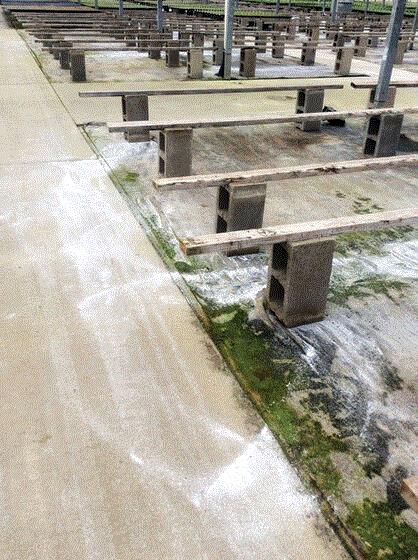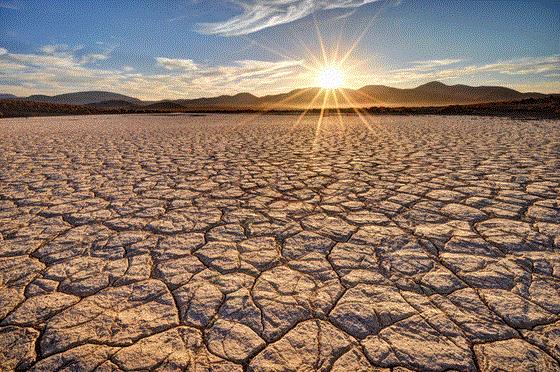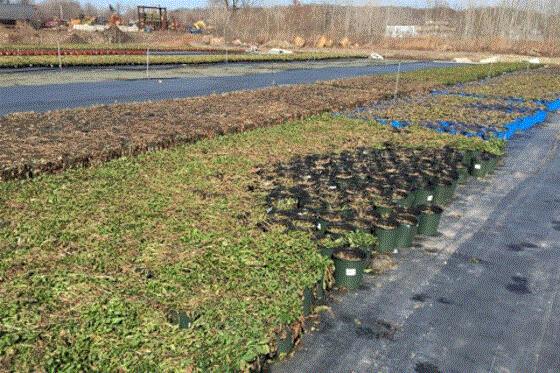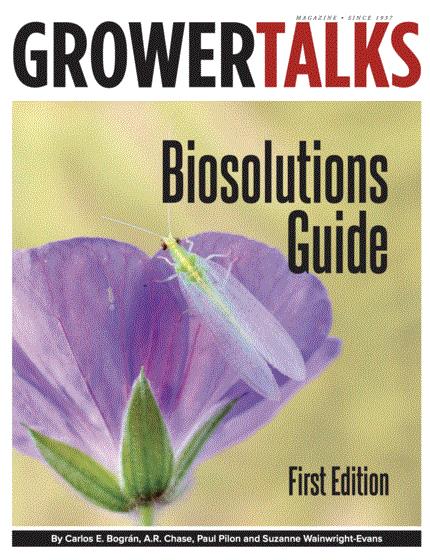Breaking the “Green Bridge”
I’ve been hearing the phrase “breaking the green bridge” in relation to disease mitigation, so when it came up again in a Tech On Demand team meeting I decided to ask for some clarification or a definition to share. Here’s what I gleaned from our floriculture disease experts and pathologists:
A big help in breaking the pest and disease cycle that occurs every year in greenhouse production is to “break the green bridge,”which consists of plants, living or dead plant debris, organic matter or an environment (empty containers, soil-filled cracks or unpaved greenhouse floors) that allows pathogens and pests to hide, survive or overwinter when there is not active crop production. The green bridge can be inside or outside the greenhouse.
Breaking the green bridge is a plant pathology term that encompasses removal of all alternative “hosts/ matrices” with a potential to harbor pests in a production system. The term originated from field production, where weeds may be left in the field creating a “green bridge” from one season to the next. In greenhouse production, the term is used to denote a thorough cleanout and cleanup of a greenhouse production space.

Breaking the bridge includes removal of all plant material, pots, debris, plastic tarps, and any alternative plant hosts from the facility, followed by a deep cleaning and sanitation of all surfaces (floors, walls, benches, etc.) After greenhouse areas have been cleaned, they must be kept free of plants for a minimum of three weeks.
Here are some resources to help you build a process at your operation to break the green bridge and start clean:

Nick’s Tip of the Week: Crud Happens …
Each week, I’ll work with my buddy Nick Flax, a technical services expert at Ball, to share a concern that’s come up during one of his numerous calls with growers across North America. This week, he’s got crud on his mind.
PROBLEM: Over the past couple months, Bill and I have covered a wide range of pests, diseases and physiological challenges for poinsettias here in the newsletter. With only a couple of weeks until Thanksgiving and the end of the 2023 poinsettia season in sight, there couldn’t possibly be more hurdles, right?
Well, while I wish I could say you can now just coast to the finish line, that’s not the case! Over the last two weeks, I’ve gotten an uptick in reports of an issue that can render even the most beautiful poinsettia unsalable overnight: crud. Yes, crud.

NICK’S TIP: If you’ve recently walked into your poinsettia house and found little pools of whiteish goop or residue sitting on your bracts, you’ve got a case of crud. While I’m uncertain where this term was first coined (please reach out to Bill or Nick if you know the true origin story!), the more technical term for this disorder is “latex eruption.”
Most often, these blobs or puddles of latex-rich vascular fluid are found on the upper surface of bracts, along the midrib or larger veins. As it dries, it congeals and forms a crust that can look almost like a mealybug and almost always discolors the affected bract. Sooty mold also tends to grow on the residual vascular fluid, and it’s virtually impossible to rinse off.
Why does this disorder occur? Remember a few weeks ago when I talked about turgor and its influence on leggy poinsettias? Well, our good friend turgor is the main culprit in the case of crud in poinsettias.
Excessive turgor pressure causes cell walls in bracts and leaves to burst, and then vascular fluid erupts out of the plant. This occurs most often when growing media is overly wet going into the night or when nighttime air temperature is high.
Salt accumulation in the growing media can also be a factor in incidences and severity of latex eruption. Since plants aren’t growing rapidly at this point in the crop cycle but roots will still take up excess fertilizer salts in the media, additional salt uptake often forces roots to take up additional water to maintain osmotic balance. When excess moisture is present, this forced uptake may cause turgor pressure to increase and either cause or increase the severity of latex eruptions in your crop.
Unfortunately, once latex eruption occurs, there is no way to undo the damage. Some varieties are more prone to this disorder than others, and incidences and severity of “crud” will vary from one operation to the next. Since moisture management and temperature are the primary drivers for this disorder, occurrences are typically more severe in hot spots throughout your greenhouses or areas with poorer air flow. As such, it’s best to focus on prevention:
-
Allow moderate dry-down between waterings.
-
Increase airflow and air exchanges (when possible) during the daytime to help drive transpiration and shorten the time that media is remains saturated.
-
Avoid watering late in the day unless plants are dangerously dry and at risk of wilting.
If moderate to severe damage occurs, it’s wise to apply a foliar fungicide, as damaged tissue provides an easy entry point for pathogens like Botrytis.
And remember, if all else fails and bracts are damaged enough to make them unsalable as they are, you can always dress them up a bit with plant-safe spray dyes or glitter products rather than throw them away.

New Consumer Gardening Report Offers Great News!
I try to stick to cultural and technical content in this newsletter and leave consumer stories to our capable retail newsletter editors. But this is too good not to share! The research team at Axiom recently released their annual GARDENING OUTLOOK SURVEY, and it is packed with data-driven insights and deep dives into lawn and garden purchasing habits, based on their recent survey of 500 consumers.

Here are just five of the high-level findings as detailed in the executive summary. I suggest you click the link above and get a copy of the full report, because (trust me) you want to see how all of these results break out by demographic. I was super energized seeing how engaged our new core group of Gen X and millennial shoppers are in gardening and how the emerging Gen Z and Y groups are using our products to improve their lives.
Despite economic concerns, respondents spent more money on gardening in 2023 and plan to spend more money in 2024.
-
48.5% of respondents reported spending more money in 2023 compared to 2022.
Despite returning to work, respondents spent more time gardening in 2023 and plan to spend more time gardening in 2024.
-
45.3% of respondents reported spending 50-100% more time in their gardens in 2023 compared to 2022.
Respondents plan to plant more and expand their gardens in 2024.
-
64.7% of respondents plan to plant more and expand their gardens in 2024.
Independent garden centers important sources of new and unique plants and information.
-
59.9% of respondents reported the same number of visits to independent garden centers, and 19.5% reported more visits to independent garden centers in 2023.
Top 3 gardening projects for 2024 include curb appeal gardens, creating vegetable gardens and growing new kinds of vegetables and fruits.
-
57.6% of respondents reported their #1 2024 project is creating front-of-the-house plantings that increase the curb appeal. For Gen X respondents, this percentage increases to 61.4%.

Webinar: Mitigating Drought Risk
Depending on where you’re located, water availability and quality could be top on your list of concerns or somewhere down the line below labor, supply chain or a few other currently hot topics. But no matter where in the world you grow plants, the impact of drought should be on your radar. Even if it’s not a current stressor, your operation should have a plan in place for if (when) it becomes a challenge.
The team at Erfgoed specializes in greenhouse flooring and irrigation, making them hypersensitive to any and all issues impacting water. They’re experts in water management, and they work with greenhouse clients around the world on innovative projects. They also share information constantly to help educate our industry, which I have always respected.

On November 16, Erfgoed experts are conducting a free webinar titled HOW TO SECURE QUALITY WATER FOR YOUR NURSERY LONG-TERM. Here’s what they plan to cover:
Every year, we witness the consequences of drought and extreme rainfall events worldwide. What does this mean for your nursery? You will not be able to grow high quality plants you desire, and your customers will be disappointed. If you are not prepared, it could harm your business. You don’t want that.
In this webinar, Jack Ford, representative of ErfGoed in the U.S., will speak about the challenges, answer your questions, and offer possible solutions, including:
-
Ensure a sufficient pipeline and storage capacity. To be able to withstand dry periods, it is important to collect the available water. Jack will show you some examples.
-
Create separation of water streams. Not every type of water is the same. You need to establish separate water streams to give each stream the right treatment and obtain the right quality of water.
-
Use the available water as economically as possible. It may seem obvious, but Jack will show you some examples.
-
Choose the right irrigation system. Of course, it needs to be perfect for your crop. You could combine it with water-saving methods.

Overwintering Perennials: Tips & Tricks
Preparing perennials for overwintering is all about the survival and health of the plants’ root system. To minimize or eliminate losses, you should take steps to maximize overall plant health before winter, acclimating crops to cold weather as temps drop, and reducing de-acclimation as extremely cold winter weather sets in. Even perennials that seem to survive just fine in the landscape can be at risk when spending winter months in pots above ground.
My fellow newsletter editor (and perennial guru) Paul Pilon, covered this important topic in a GROWERTALKS ARTICLE last year, and I think it’s worth sharing again now. Many of you overwinter perennials for a variety of reasons, including the ability to spread out labor and reduce some planting anxiety in spring, taking advantage of bulking to build up the plant structure, boost plant quality and, of course, to reduce energy costs. For many, it’s worth any associated risks.

But there are risks, which you can minimize by following Paul’s advice related to improving root health, cold protection in early winter and managing the environment within overwintering houses in the dead of winter. The full article is linked above.
For those of you who prefer an audio version, the Minimizing Risk article is also available as an AUDIO FILES PODCAST from Tech On Demand.

Finish Line …

Heading into the 2024 production season, you and your team might be adding more biological controls to your plant protection arsenal. I want to remind you about the BIOSOLUTIONS GUIDE Ball Publishing published this year.
In this resource guide, you’ll find a glossary, as well as efficacy tables, a look back on biosolutions over the past 30 years, and fast facts on the most used beneficials. Click the link above to access the digital supplement.
While you’re at it, you might as well bookmark our other special editions. Each one is an excellent resource to have at your fingertips and to use when planning for upcoming seasons or solving problems on the fly.
Have a fantastic week! I’ll be back next Friday …
Please feel free to send your comments, constructive criticism and topic ideas to me at bcalkins@ballhort.com.

Bill Calkins
Editor - Tech On Demand
This email was received by you and 26,028 other fine subscribers!
If you're interested in advertising in Tech On Demand, contact Kim Brown ASAP and she'll hook you up.